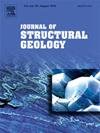莺歌海盆地高分辨率地震资料揭示的红河断裂带及其深部构造特征
IF 2.9
2区 地球科学
Q2 GEOSCIENCES, MULTIDISCIPLINARY
引用次数: 0
摘要
以红河断裂带(RRFZ)为北界的印度支那地块相对华南地块的侧向挤压是对印度-欧亚板块碰撞辐合所造成的大量变形的响应和调节。然而,RRFZ的构造性质仍然是一个有争议的话题。新生代莺歌海盆地(YGHB)受RRFZ控制,其厚厚的地层中保存了该地区的构造历史。高分辨率地震资料分析表明,RRFZ包括1号断裂、中央断裂等基底断裂与莫霍断裂带相交,具有岩石圈尺度。根据首次发现的T83层位推断,YGHB地区RRFZ的走滑剪切作用可追溯到约40.4 Ma以前。莫霍面在中央坳陷(CD)内表现为隆起和平缓的起伏,最小深度小于19 km。在CD底辟带,地壳厚度在4 ~ 5 km之间,拉伸系数为5.2 ~ 6.5,显示出明显的减薄和超伸展,下地壳低角度正断层的存在证明了这一点。沿中央断裂和1号断裂的走滑剪切作用,加上多次构造反转,促进了YGHB北部构造反转的发展。全面了解RRFZ对YGHB的油气勘探至关重要。本文章由计算机程序翻译,如有差异,请以英文原文为准。
The red river fault zone and its deep structural characteristics revealed by high-resolution seismic data in the Yinggehai basin, South China sea
With the Red River Fault Zone (RRFZ) as the northern boundary, the lateral extrusion of the Indochina Block relative to the South China Block is a response and accommodation to the substantial deformation resulted from the collision and convergence of the India-Eurasia plates. However, the tectonic nature of the RRFZ remains a topic of debate. The Cenozoic Yinggehai Basin (YGHB), controlled by the RRFZ, preserves the tectonic history of the region in its thick strata. Analysis of high-resolution seismic data indicates that the RRFZ, including the No.1 Fault, Central Fault, and other basement faults, intersects the Moho, suggesting its lithospheric-scale nature. Strike-slip shearing along the RRFZ in the YGHB dates back to approximately 40.4 Ma ago, as inferred by the T83 horizon distinguished for the first time. The Moho surface exhibits uplift and gentle undulations within the Central Depression (CD), with a minimum depth less than 19 km. In the diapir zone of the CD, crustal thickness ranges from 4 to 5 km, with stretching coefficient of 5.2–6.5, indicating significant thinning and hyper-extension, evidenced by the low-angle normal faults in the lower crust. Strike-slip shearing along the Central Fault and No.1 Fault, coupled with multiple structural inversions, facilitated the development of structural inversion in the northern YGHB. A comprehensive understanding of the RRFZ is crucial for oil and gas exploration in the YGHB.
求助全文
通过发布文献求助,成功后即可免费获取论文全文。
去求助
来源期刊

Journal of Structural Geology
地学-地球科学综合
CiteScore
6.00
自引率
19.40%
发文量
192
审稿时长
15.7 weeks
期刊介绍:
The Journal of Structural Geology publishes process-oriented investigations about structural geology using appropriate combinations of analog and digital field data, seismic reflection data, satellite-derived data, geometric analysis, kinematic analysis, laboratory experiments, computer visualizations, and analogue or numerical modelling on all scales. Contributions are encouraged to draw perspectives from rheology, rock mechanics, geophysics,metamorphism, sedimentology, petroleum geology, economic geology, geodynamics, planetary geology, tectonics and neotectonics to provide a more powerful understanding of deformation processes and systems. Given the visual nature of the discipline, supplementary materials that portray the data and analysis in 3-D or quasi 3-D manners, including the use of videos, and/or graphical abstracts can significantly strengthen the impact of contributions.
 求助内容:
求助内容: 应助结果提醒方式:
应助结果提醒方式:


